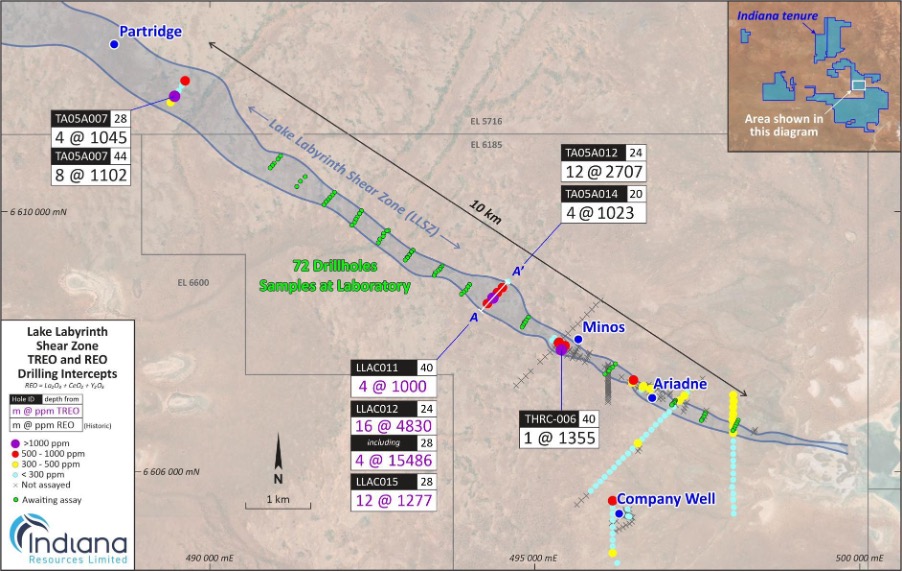Indiana Resources goes full throttle in chase for South Australian rare earths bounty

There’s no slowing down for Indiana Resources in its hunt for elusive high value critical minerals. Pic via Getty Images
Hot off the heels of its major rare earths discovery in South Australia’s Gawler Craton, Indiana Resources is on the hunt for more, resampling 72 existing drillholes in search for the suite of high value critical minerals.
Indiana Resources (ASX:IDA) lit up the market last week with high grade results from six initial drill holes which contained total rare earths oxides of up to 15,486ppm or 1.55%.
48% of those TREOs were high value magnet rare earths like neodymium, dysprosium, terbium and praseodymium, key components in the permanent magnets used in wind turbines and EVs, a market the world’s leading supplier outside of China, Lynas Rare Earths (ASX:LYC), expects to double by 2030.
Significant results to date include:
- 48m @ 1,948ppm TREO from 20m (LLAC012) including 16m @ 4,830ppm TREO from 24m including 4m @ 15,486ppm (1.55%) TREO from 28m
- 49m @ 720ppm TREO from 20m (LLAC015) including 12m @ 1,277ppm TREO from 28m; and,
- 40m @ 769ppm TREO from 20m (LLAC011) including 4m @ 1,000ppm TREO from 40m.
Little wonder then that Indiana has moved fast to re-assay 1035 samples from 72 existing aircore holes covering a massive 6km strike of the Lake Labyrinth Shear Zone.
“The ability to move quickly to re-assay existing samples for the full suite of REE is of tremendous value for the Company as we seek to confirm the extent of rare earth potential of our project area encouraged by the high-grades and the high proportion of magnet REEs in these initial samples,” IDA technical director Felicity Repacholi-Muir.
“We have started planning for follow up drilling and the assays from this larger, more extensive drill data set will assist us in refining our program.”

Full suite assay incoming
The high-grade samples from the initial six drill holes have also been submitted for full rare earths suite assay.
They were initially drilled at the 5713sqkm Central Gawler Project back in 2021, but were reviewed after IDA outlined a number of anomalous REE accumulations within the project following a review of previous exploration drilling results.
Those accumulations were based on a partial analysis of the REE suite of cerium, lanthanum and yttrium, the most abundant and lowest value of the suite.
The discovery of high-grade magnet rare earths has transformed the value proposition for the project, with those products currently garnering prices in the Chinese spot market well above historical averages and demand expected to increase with decarbonisation.
Additional assay results are expected in 4-6 weeks depending on turnaround time.
Drive for more data
IDA says work is now in progress to collect additional data to define the distribution of the different rare earths in the weathering profile and to identify any underlying potential bedrock lithological or structural controls on the distribution of the mineralisation.
The company believes the Lake Labyrinth Shear Zone contains a prospective corridor of 10km, with targets also present at the Hicks Well prospect and 4km west of the Company Well prospect, which could be part of a parallel structure to the northwest trending LLSZ.
Previous magnetic and electromagnetic imagery will also be interpreted to map out deeper regolith profiles, settings favourable for REE accumulation, IDA said.
This article was developed in collaboration with Indiana Resources, a Stockhead advertiser at the time of publishing.
This article does not constitute financial product advice. You should consider obtaining independent advice before making any financial decisions.
Related Topics

UNLOCK INSIGHTS
Discover the untold stories of emerging ASX stocks.
Daily news and expert analysis, it's free to subscribe.
By proceeding, you confirm you understand that we handle personal information in accordance with our Privacy Policy.








